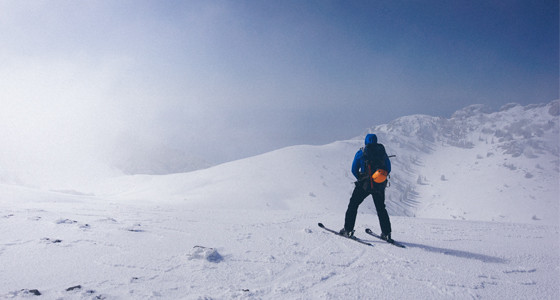
Simple Backcountry Travel Protocol
Sledders, skiers and snowboarders who recreate on winter slopes steeper than 30 degrees should understand where and how avalanches happen. It’s a good idea to take a class. Learning about terrain, what weather factors may lead to avalanching and having an idea how to assess snow stability are critical components to safe outings.
That being said; if you are recreating on steep slopes you can never be one hundred percent sure the slope will not slide. This is true whether you are on a ski area or in the backcountry. Yes, it’s possible to be reasonably certain the slope won’t go; but there are no absolute guarantees on slopes steeper than 30 degrees. Avalanche professionals attend workshops on a regular basis about “surprise” avalanches.
Since avalanches are not one hundred percent predictable; it’s a good idea to travel in avalanche terrain as if the slope could possibly slide. To that end, I teach a simple three-step approach to traveling in the winter backcountry: 1. One at a time 2. Get out of harm’s way 3. Stay within striking distance.
After we’ve done our homework checking the weather and the snowpack and deemed it is relatively safe to ski, ride or travel on a steep slope we can follow the simple three steps.
- One at a time – everyone knows this right? The backcountry mantra; only expose one member of the party at any one time to avalanche hazard. It works; if something does go wrong there will only be one person involved. There is no reason not to practice one at a time. There are estimates that one half of the avalanche fatalities in Montana could have been prevented if people had followed this one simple step.
- Get out of harm’s way – again, something we have repeated many times. Once we have ridden, skied, high-marked or traveled across a slope, get out of the way of your partners or a possible avalanche. We do need to understand avalanche slopes, starting zones, flanks and runouts to make this work. We have to learn where the hazard is to avoid it. And sometimes we do make mistakes thinking we know where that boundary between safe and not safe lies. In a “surprise avalanche” seminar I attended some of the presentations were about professionals wrongly guessing where that boundary lay. There is risk in recreating in avalanche terrain and humans make mistakes. But, if we make the conscious effort, every time, to get out of harm’s way after we have skied or ridden the slope, we will reduce accidents. More importantly, we stack the odds in our favor of not getting caught in a triggered slide. It’s hard to affect a rescue for your partner if you’re in the slide with them.
- Stay within striking distance – in other words try to stay where you can reach your partner relatively quickly if something does happen. Get out of harm’s way but stay within reach; maintain visual contact if possible. We know you don’t have much time if you’re buried. We need to respond quickly and efficiently. Even if a person is on top of the snow and breathing there may be other injuries that require immediate attention. In bigger terrain or more complex terrain, getting out of harm’s way and staying within striking distance gets more challenging. In larger terrain I’ve skied it just wasn’t possible to ski to a relatively safe place and have a constant visual on my partners. Three step protocols have their limit and mountain travel is not always black and white; there are gray areas. Let us be crystal clear about that; skiing and riding bigger and more complex terrain necessarily requires the participant to accept more risk. Small hand-held radios are a good idea in terrain where you cannot always see your partners.
Lao Tzu said “nature is not human hearted”. Snow stability is not dependent on how you’re feeling that day. It is a good idea to practice some discipline with good travel protocol. Going one at a time, getting out of harm’s way and staying within striking distance can increase safety and reduce decision heartburn.
Dudley Improta is retired from the University of Montana and the West Central Montana Avalanche Center. He is a certified instructor with the American Avalanche Association and teaches basic and Level 1 avalanche classes for Yurtski, a backcountry operation north of Missoula.